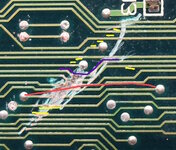Because of the quantity of traces, this may be tedious. However, you will get lucky if all the traces end in a via solder blog, because that is easy to patch.
First, clean the area with isopropyl alcohol to remove dust, particles, and press down any stray copper edges.
Next, with a scalpel, gently scrap away green solder mask from areas that are lightly scratched but not broken (examples marked in yellow on the image below). You want a clean copper surface in those spots.
Now clean the scraped areas with isopropyl again.
Apply solder flux and then solder on those scratched but not broken areas. This makes sure all of the scratched-but-not-broken places have a solid (not intermittent) connection.
Using a multimeter and great skepticism, check every single trace in the scratched region for continuity. Use the longest span that you can. That is, if you can measure from one via to the other and cover several scratched areas in a single trace -- great. You want to be absolutely sure you know which traces are good.

Let's say that leaves you with 10 broken traces.
The best method is to solder a wire (magnet wire or plastic insulated) from one via to the other. For example, the red line shows a broken trace where you can see both ends have a nice round via/pad to solder to. The wire now takes the place of the via. Easy!
But if the ends are far away or don't have nice ends to solder insulated wires to, then consider using a short length of uninsulated / bare tinned copper wire (aka buss wire). In the purple line above, I would scrape away the solder mask until I had good copper exposed across the entire region of the break. I would then flux and coat the copper with solder as flat as possible. Then put the bare wire on one end and tack it in place with solder. Then bend the wire to match the trace. Then apply flux. Then solder the other end of the wire carefully. Once that is solidly in place, go to the other end and resolder the "tacked" end carefully. Because this is tedious, the via-to-via with an insulated wire is preferred whenever possible.